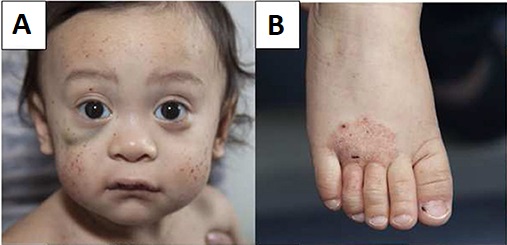Wiskott-Aldrich Syndrome 2

A number sign (#) is used with this entry because of evidence that Wiskott-Aldrich syndrome-2 (WAS2) is caused by homozygous mutation in the WIPF1 gene (602357) on chromosome 2q31. One such patient has been reported.
For a discussion of genetic heterogeneity of Wiskott-Aldrich syndrome, see WAS (301000).
Clinical FeaturesConley et al. (1992) raised the possibility of the existence of an autosomal recessive form of Wiskott Aldrich syndrome. They observed an 8-year-old girl with a disorder phenotypically identical to the disorder in males with an X-linked mutation (WAS; 301000). Cytogenetic studies showed no structural abnormalities of the X chromosome and X-chromosome inactivation analysis showed that both X chromosomes could function as the active X.
Lanzi et al. (2012) reported an 11-day-old female Moroccan infant with Wiskott-Aldrich syndrome-2. She was born to consanguineous parents who had previously lost a daughter at age 4 months with recurrent infections. The WAS2 patient presented with features of Wiskott-Aldrich syndrome, including recurrent infections, eczema, and thrombocytopenia. Immunologic analysis showed low numbers of B cells and T cells, particularly CD8 (see 186910)-positive T cells. The number and percentage of natural killer (NK) cells were increased, but NK-cell functional activity was drastically reduced. IL2 (147680) corrected the partial proliferation defect in T cells from a WAS patient, but it failed to correct the complete T-cell proliferation defect in the WAS2 patient. Unlike patients with WAS, who show impaired T-cell chemotaxis, the WAS2 patient showed no response to IP10 (CXCL10; 147310), in association with poor expression of IP10 receptor (CXCR3; 300574). Platelet volume was normal. The WAS2 patient had undetectable WASP (300392), like WAS patients, but normal WASP sequence and mRNA levels. WIPF1, which is required for stabilization of WASP, was also undetectable. Unrelated cord blood transplantation at age 4.5 months restored immunologic function, and the WAS2 patient was healthy 16 months after the procedure.
MappingWiskott-Aldrich syndrome-2 is caused by mutation in the WIPF1 gene, which maps to chromosome 2q31.1 (Gross, 2012).
Molecular GeneticsIn a Moroccan infant with WAS2, Lanzi et al. (2012) identified a homozygous ser434-to-ter (S434X; 602357.0001) mutation in the WIPF1 gene. The parents were heterozygous for the mutation. Expression of WIPF1 in the patient's T cells corrected the defect in WASP expression.